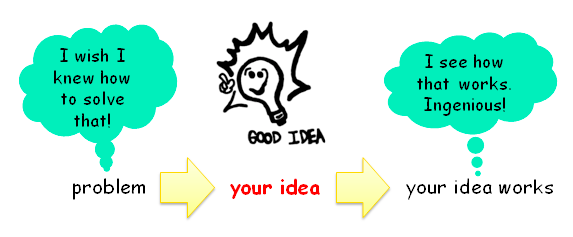Develop your Central Message
 Your goal is to infect the mind of your reader with your idea, like a virus! Remember, a (scientific) idea is a re-usable insight, useful to the reader or audience of the paper. It is henceforth crucial to develop your idea into a central message [1]. This requires you to:
Your goal is to infect the mind of your reader with your idea, like a virus! Remember, a (scientific) idea is a re-usable insight, useful to the reader or audience of the paper. It is henceforth crucial to develop your idea into a central message [1]. This requires you to:- Figure out what your idea is! [1]
- Make certain that the reader is in no doubt what the idea is. Be 100% explicit: "The main idea of this paper is…." and "“In this section, we present the main contributions of the paper." [1]
- To avoid the most common fallacy: many papers contain good ideas, but do not distil what they are into a central message. [1]
Developing a central message on which the whole paper ![]() is focussed is one of the most important parts of writing your paper [2]. This step often overlooked as people often have a hard time differing between what is an important idea and the foundations it is based on [2]. Think carefully about what it is that you want your readers to understand about your work. Remember, we are all busy and we need to absorb your message quickly and clearly [1]. Try these exercises [2]:
is focussed is one of the most important parts of writing your paper [2]. This step often overlooked as people often have a hard time differing between what is an important idea and the foundations it is based on [2]. Think carefully about what it is that you want your readers to understand about your work. Remember, we are all busy and we need to absorb your message quickly and clearly [1]. Try these exercises [2]:
1. Write down the three central points of your paper.
| Central Point 1: | |
| Central Point 2: | |
| Central Point 3: | |
2. Summarize your paper in one sentence.
3. Describe your work to a colleague in one minute.
These exercises might sound easy, but try them and you'll find out they aren't! [2] Did it work for you? No? Then let's go into some more detail.
Central Points of the Paper
Developing the central points of a paper is often quite simple in computer science. It could simply be [1]:
- Here is a problem! It’s an interesting problem! It’s an unsolved problem!
- Here is my idea! Here is how it is motivated!
- My idea works (with evidence such as details, data)! Here’s how my idea compares to other people’s approaches
Here is a graphical representation of this mildly general approach to writing CS papers:
 (based on [1])
(based on [1])Now, try again! Does it work easier for you?
Summarize Your Paper in One Sentence and Describing it to a Colleague
Summarizing your paper in one sentence is much less straightforward but more crucial:
- Your paper should have just one “ping”: one clear, sharp idea [1]
- Read your paper again: can you hear the “ping”? [1]
- You may not know exactly what the ping is when you start writing; but you must know when you finish! [1]
Note: If you have lots of ideas, write lots of papers. Don't put more than one ping into one paper. [1]
Don't rush this part of your planning. It is worth spending time getting it right. Once you have mastered these exercises you will feel more confident about the whole writing process that follows. [2]
A common problem with summarizing your work is that there are usually several major findings. This exercise is meant to focus your thinking on the central issues. It is not going to form the published abstract. So, if you really can't squeeze your key message into one sentence don't worry. Try to do it in two. If you can't do that then you need to take a careful look at the reasons. Remember, this is a very important part of the process for writing papers so work at it. Talk to your colleagues and see if between you it is possible to highlight the central message of your work. [2]
